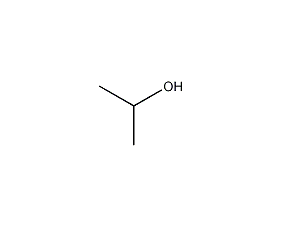Isopropyl alcohol Isopropyl alcohol


Structural formula
| Business number | 01EU |
|---|---|
| Molecular formula | C3H8O |
| Molecular weight | 60.10 |
| label |
2-Propanol, dimethylmethanol, 2-Pronanal, sec-Propyl alcohol, Isopropanol, Aliphatic alcohols, ethers and their derivatives, Raw materials and intermediates used in ink |
Numbering system
CAS number:67-63-0
MDL number:MFCD00011674
EINECS number:200-661-7
RTECS number:NT8050000
BRN number:635639
PubChem number:24896158
Physical property data
1. Properties: Colorless and transparent liquid, smelling like a mixture of ethanol and acetone. [1]
2. Melting point (℃): -88.5[2]
3. Boiling point (℃): 82.5[3]
4. Relative density (water = 1): 0.79[4]
5. Relative vapor Density (air=1): 2.1[5]
6. Saturated vapor pressure (kPa): 4.40 (20℃)[6]
7. Heat of combustion (kJ/mol): -1995.5[7]
8. Critical temperature (℃): 235[8]
9. Critical pressure (MPa): 4.76[9]
10. Octanol/water partition coefficient: 0.05 [10]
11. Flash point (℃): 11 (CC) [11]
12. Ignition temperature (℃) ): 456[12]
13. Explosion upper limit (%): 12.7[13]
14. Explosion lower limit (%): 2.0[14]
15. Solubility: Soluble in most organic solvents such as water, ethanol, ether, benzene, and chloroform. [15]
16. Viscosity (mPa·s, 20ºC): 2.431
17. Heat of evaporation (KJ/mol, b.p.): 40.06
18. Heat of fusion (KJ/kg): 88.26
19. Heat of formation (KJ/mol): 2005.1
20. Specific heat capacity (KJ/(kg ·K), 20ºC, constant pressure): 2.55
21. Conductivity (S/m): 35.1×10-7
22. Heat Conductivity (W/(m·K), 20ºC): 15.49
23. Volume expansion coefficient (K-1, 20ºC): 0.00107
24. Relative density (20℃, 4℃): 0.7855
25. Relative density (25℃, 4℃): 0.7813
26. Refractive index at room temperature (n 25): 1.3752
27. Critical density (g·cm-3): 0.271
28. Critical volume (cm3·mol-1): 222
29. Critical compression factor: 0.250
30. Eccentricity factor: 0.669
31. Lennard-Jones parameter (A): 15.20
32. Lennard-Jones parameter (K): 135.4
33. Solubility parameter (J·cm-3)0.5: 23.575
34. van der Waals area (cm2·mol-1): 6.270×109
35. van der Waals volume (cm3·mol-1 ): 42.160
36. Gas phase standard combustion heat (enthalpy) (kJ·mol-1): 2051.42
37. Gas phase standard claimed heat (enthalpy) )( kJ·mol-1): -272.42
38. Gas phase standard entropy (J·mol-1·K-1 ): 309.20
39. The gas phase standard is generated from�� and anti-fogging agents for transparent plastics, etc. Used as a diluent for adhesives, antifreeze, dehydrating agent, etc.
2. Reagents for the determination of barium, calcium, copper, magnesium, nickel, potassium, sodium, strontium, nitrite, cobalt, etc. Chromatographic standards. As chemical raw materials, it can produce acetone, hydrogen peroxide, methyl isobutyl ketone, diisobutyl ketone, isopropylamine, isopropyl ether, isopropyl alcohol ether, isopropyl chloride, as well as fatty acid isopropyl ester and chlorine Substitute fatty acid isopropyl ester, etc. In fine chemicals, it can be used to produce isopropyl nitrate, isopropyl xanthate, triisopropyl phosphite, aluminum triisopropoxide, medicines and pesticides, etc. As a solvent, it can be used to produce coatings, inks, extractants, aerosols, etc. It can also be used as antifreeze, detergent, additive for blending gasoline, dispersant for pigment production, fixative for printing and dyeing industry, anti-fogging agent for glass and transparent plastic, etc.
3. Used as a defoaming agent for water-based fracturing fluids in oil wells. Air forms an explosive mixture, which can cause combustion and explosion when exposed to open flames or high heat. It can react with oxidants. Its vapor is heavier than air and can spread to a considerable distance from a lower place, causing backfire when encountering a fire source. If exposed to high heat, the internal pressure of the container will increase and there is a risk of cracking and explosion.
4. Isopropyl alcohol is used as a cleaning and degreasing agent. MOS grade is mainly used for discrete devices and medium and large-scale integrated circuits, and BV-III grade is mainly used for very large-scale integrated circuit technology.
5. Used in the electronics industry as a cleaning and degreasing agent.
6. Used as a diluent for adhesives, an extractant for cottonseed oil, and a solvent for nitrocellulose, rubber, paint, shellac, alkaloids, grease, etc. It is also used in antifreeze, dehydrating agents, preservatives, anti-fogging agents, medicines, pesticides, spices, cosmetics and organic synthesis, etc.
7. It is a relatively cheap solvent in industry, has a wide range of uses, can be freely mixed with water, and has stronger solubility for lipophilic substances than ethanol.
8. It is an important chemical product and raw material. Mainly used in pharmaceuticals, cosmetics, plastics, spices, coatings, etc. [29]
